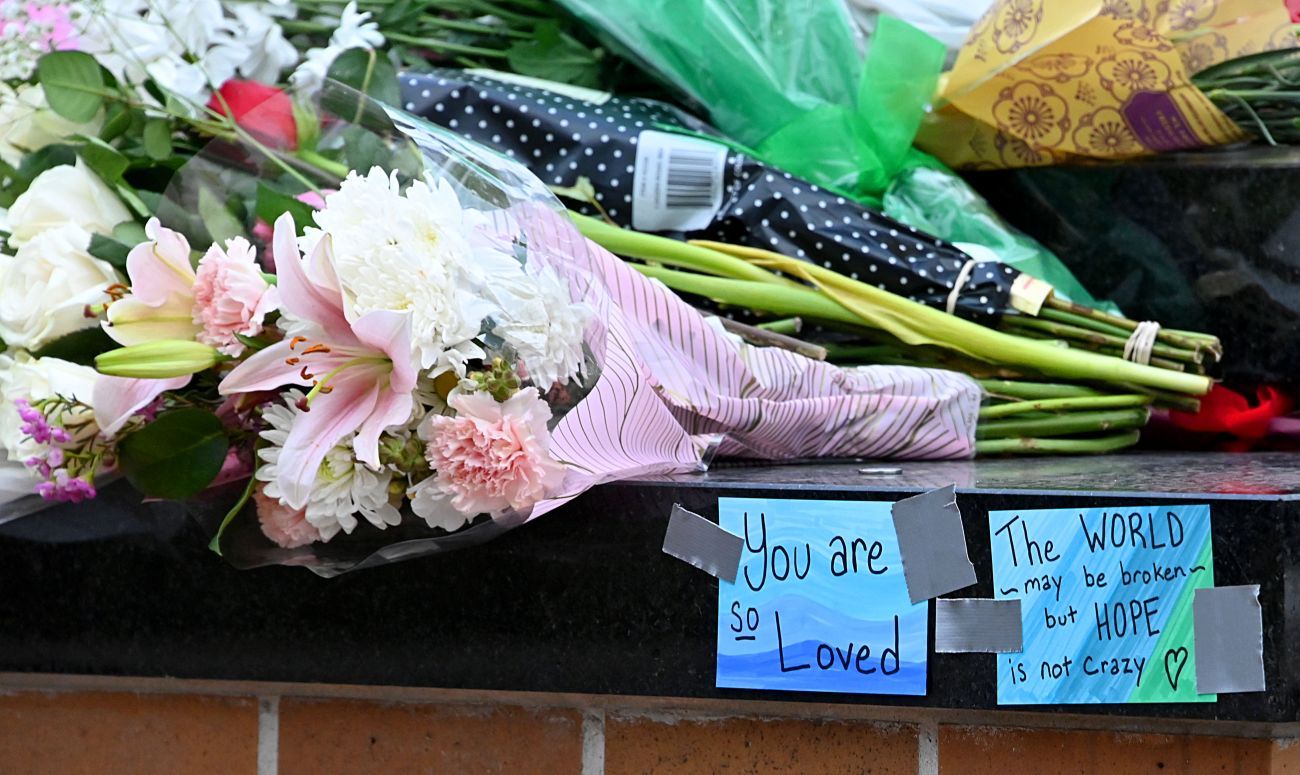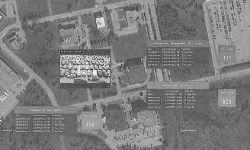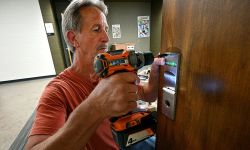Michigan State shooting: University lacked security common on other campuses

- Most Michigan colleges have live camera feeds and many have locks inside classrooms, two features not available at Michigan State Feb. 13
- Safety features vary, however, with authorities at some campuses able to lock down all or some buildings from a remote location. Others, including Michigan State, cannot.
- A state representative is proposing $100 million pot of money for upgrading campus security this year.
April 6: Nashville releases records soon after school shooting. Not so much with MSU
March 24: MSU offered active violence training. Few attended before shooting
March 16: Michigan Senate OKs sweeping gun control reforms after MSU shooting
March 15: MSU's long path ahead: What other universities have done after mass shootings
Oakland University professors felt vulnerable in their own classrooms.
With on-campus attacks becoming more prevalent nationwide, they worried the only way to lock a classroom was to leave it — and lock it from the outside with a key.
“If there’s an active shooter in the hall, you can’t ask us to go in the hall to lock the door,” said Karen AJ Miller, an associate professor of history and president of the faculty union, told Bridge Michigan.
Related:
- From the gunfire at MSU, an emerging class of determined gun activists
- MSU shooting: Rampage over in 8 minutes, timeline shows
- MSU shooter motive hinted at in note: ‘They made me who I am today a killer’
- As Michigan boosts school security after shootings, how much is too much?
- Democrats push Michigan gun reforms. Here’s what the laws are now
- ‘We’re so angry.’ MSU students urge gun safety at Lansing hearing
So in 2018, the faculty union asked administrators to upgrade locks, and by the time classes resumed in January 2019, thumb-lock deadbolts had been installed across campus.
That’s in stark contrast to what students and staff discovered at Michigan State University when they couldn’t lock doors, despite an active shooter on campus who would kill three students and wound five others Feb. 13.
Bridge Michigan surveyed campus security at colleges and universities statewide and found that MSU lacked several features common elsewhere.
The survey, completed by 20 schools, found that many schools can lock down all buildings from a central location and most can monitor any camera on campus. Those are features Michigan State police hope to implement soon but which were not available during last month’s attack that began at Berkey Hall and continued at the MSU Union.
Though not exhaustive, Bridge’s survey revealed that all schools are making efforts to provide active shooter training and are adhering to federal law that requires emergency alerts of ongoing threats.
There are plenty of differences in security levels, as well, and those are prompting Rep. Samantha Steckloff, D-Farmington Hills, to propose $100 million for upgrades for public and private colleges and universities statewide, she told Bridge on Wednesday.
Without divulging details, she said she has found a funding source for the improvements and has the support of Republicans and other key Democrats, who control the House and Senate.
“My apartment is very close to Sparrow Hospital. So all night long (on Feb. 13), every ambulance I heard I knew it was a student,” she said. “And while I couldn't do anything then, I can do something now. And that's why we're doing this.”
Steckloff’s committee is taking testimony Thursday morning from Michigan State officials, along with others from Central Michigan and University of Michigan-Flint as the committee considers how to improve campus security.
Colleges and universities currently get money for facility upgrades, money that could be used for campus security or to fix roofs or replace windows.
Steckloff said she’s proposing a new vein of funding dedicated to improved security, so colleges don’t have to choose between a roof repair or more classroom locks.
Security results
Bridge reached out to 69 public and private colleges and universities and found inside classroom locks are common at many schools, though they were not available in Berkey Hall, where two of three students were killed at MSU.
The variety also shows that each institution is following its own path toward securing campus, with no state standards existing to guide them.
Michigan State has announced plans to add classroom locks to all 1,300 classrooms by fall and will make other changes, interim President Teresa Woodruff announced in February.
She said the school will install more cameras and all students and employees will be required to take active violent intruder training, beginning next school year. The school is also limiting access to campus buildings between 6 p.m. and 7:30 a.m. to those with key-card access.
The attack occurred just after 8:15 p.m. in a building that was open to the public.
Classroom locks and building access
In Berkey Hall, a professor teaching class when a gunman opened fire on his students told Bridge he held the door handle in an effort to prevent the shooter from opening the door. There was no lock on his side of the door.
As at Oakland University, all classrooms can be locked from the inside at U-M Dearborn, U-M Flint, Saginaw Valley State University and Central Michigan and most community colleges and private schools that responded.
At others, however, that capability is not universal, like at Northern Michigan University and Western Michigan, where officials told Bridge they’re adding that capability to more classrooms.
Many schools also have the ability to remotely lock every exterior door of a building from a central location, like the police department.
At Michigan State, university officials said they can lock some buildings but not all from a remote location. The shooter, now known as Anthony McRae, 43, of Lansing, left Berkey Hall and traveled to the Union, where he arrived about 10 minutes later.
It was there that he shot and killed Brian Fraser, a Grosse Pointe Park sophomore.
Northern Michigan, Grand Valley State, Wayne State, U-M Dearborn, U-M Flint and most buildings at Western Michigan can be shuttered remotely. It is under consideration at Eastern Michigan which, like most campuses, limits building access to key card holders in off hours.
The capability is also present at the three private schools that responded — Kalamazoo College, the University of Detroit-Mercy and the College for Creative Studies — and at five of the community colleges: Wayne County, Grand Rapids, Washtenaw, Delta and Schoolcraft.
The University of Michigan, which declined to fill out the survey citing its reluctance to share “specifics” about security, has been adding “lockdown” buttons in some classrooms, devices that allow students or staff to immediately lock a room while also sending an emergency alert to campus police.
Melissa Overton, deputy chief of police, said U-M began installing the mechanisms in 2019.
“As the project continues, several interconnected locking systems have been installed in large classrooms with multiple entrances,” she said in an email to Bridge. “In addition, we continue to assess and identify opportunities to enhance the safety and security of our community.”
Lake Superior State did not respond to the survey request. Michigan State responded March 8, outlining changes already planned and the others which Woodruff announced, and Grand Valley State University responded March 10.
Cameras
Every college and university contacted by Bridge has cameras scanning campus — both inside and outside of buildings.
And all of them said the videos can be monitored in real-time, to keep an eye on campus or in particular areas if there was a threat.
At Michigan State, police had to review the tapes of videos from the Union to find images of McRae, and they said they could not watch the videos as the danger was unfolding.
Ultimately, they found pictures of him in a back hallway of the Union and published them nearly three hours after the shooting began. Within minutes of those pictures going public, police were tipped off to his whereabouts. McRae killed himself when confronted by police.
At other schools, officials have told Bridge they have the capability to follow a threat throughout buildings or across campus, or can review video to help solve a crime.
At the College for Creative Studies, which operates two campuses in Detroit, the college is upgrading the cameras to include artificial intelligence, said Aletha Jordan, director of operations.
The capability will allow the school to have the cameras scan campus for objects, such as a gun or an unattended bag, and alert police (she said the college will not use facial recognition capabilities).
In a recent exercise, Jordan said the staff placed a red duffle bag somewhere on campus and then asked the 90 AI-driven cameras to find it by inputting a description.
In less than 2 minutes, Jordan said, “it found the exact one.” The system was also able to review stored video and locate where else the bag had been on campus.
Experts hope similar systems can alert police to other potential threats, including guns and other weapons.
Jordan said the college has made steady improvements since a 2007 shooting at Virginia Tech University killed 32 staffers and students and wounded 17 others.
“We ramped up some more because times have changed,” Jordan told Bridge Michigan. “(Virginia Tech), that’s when we really started enhancing things.”
Active-shooter training
Mark Gordon, police chief at Oakland University, said that in addition to adding locks, the faculty also pushed for active shooter training, Gordon said.
Now, Oakland offers that training to all staff. It’s something that every campus reached by Bridge offers, though it’s voluntary in most instances.
At some schools, including Oakland Community College and Central Michigan, it is required of all new employees and students.
Editor’s note: This story has been updated since it was posted at 5:55 p.m., March 8, to include other schools that responded to Bridge Michigan’s survey including Wayne State, Eastern Michigan, Michigan State, Michigan Technological and University of Michigan-Dearborn.
See what new members are saying about why they donated to Bridge Michigan:
- “In order for this information to be accurate and unbiased it must be underwritten by its readers, not by special interests.” - Larry S.
- “Not many other media sources report on the topics Bridge does.” - Susan B.
- “Your journalism is outstanding and rare these days.” - Mark S.
If you want to ensure the future of nonpartisan, nonprofit Michigan journalism, please become a member today. You, too, will be asked why you donated and maybe we'll feature your quote next time!




